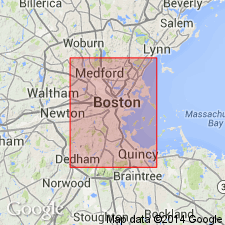
- Usage in publication:
-
- Braintree series
- Modifications:
-
- Original reference
- Dominant lithology:
-
- Slate
- AAPG geologic province:
-
- New England province
Summary:
Braintree series. Probably not far from 1,000 feet thick. Whole is fossiliferous, but it is only in upper 100 fet that well-preserved characteristic fossils are found. Is composed of beds which were evidently at time of their formation very uniform mud of a sea floor tolerably remote from land, and although much changed by metamorphic action it is easily perceived that the whole set of beds contain no trace of shore deposits. [Mentions Braintree slates, but does not say what rest of "series" consists of.]
Source: US geologic names lexicon (USGS Bull. 896, p. 250).

- Usage in publication:
-
- Braintree Argillite*
- Modifications:
-
- Overview
- AAPG geologic province:
-
- New England province
Summary:
Used as Braintree Argillite of Middle Cambrian age. Mapped undivided with Weymouth Formation. Contains Middle Cambrian fauna.
Source: GNU records (USGS DDS-6; Reston GNULEX).

- Usage in publication:
-
- Braintree Argillite*
- Modifications:
-
- Overview
- AAPG geologic province:
-
- New England province
Summary:
Braintree Argillite is present only south of Boston basin in and around Quincy Granite. Consists of noncalcareous green to dark-gray or black massive slate or argillite. Adjacent to Quincy Granite, it is indistinctly bedded greenish-gray hornfels. Thickness estimated at 1000 m (LaForge, 1932). Contact with underlying Weymouth Formation not exposed; top of formation not known. No measured section has been done by any worker. Faunal assemblage is characterized by Middle Cambrian representatives of PARADOXIDES (trilobite). At Conanicut Island in southern RI, Skehan and others (1978, 1981) describe a Middle Cambrian sequence similar to Braintree in lithology that contains trilobites BADELUSIA and PARADOXIDES. Age of Braintree is Middle Cambrian. Report contains geologic maps and correlation charts. [Chapters A-J in U.S. Geological Survey Professional Paper 1366 are intended as explanations and (or) revisions to 1:250,000-scale MA State bedrock geologic map of Zen and others (1983).]
Source: GNU records (USGS DDS-6; Reston GNULEX).
For more information, please contact Nancy Stamm, Geologic Names Committee Secretary.
Asterisk (*) indicates published by U.S. Geological Survey authors.
"No current usage" (†) implies that a name has been abandoned or has fallen into disuse. Former usage and, if known, replacement name given in parentheses ( ).
Slash (/) indicates name conflicts with nomenclatural guidelines (CSN, 1933; ACSN, 1961, 1970; NACSN, 1983, 2005, 2021). May be explained within brackets ([ ]).

